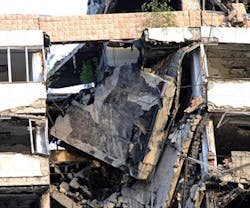How Earthquakes Affect Buildings
Permanent ground deformations can tear a structure apart. Some foundation types are better able to resist these permanent ground deformations than others. For example, the use of pile foundations, with the piles extending beneath the anticipated zone of soil liquefaction, can be effective in mitigating the hazard’s effects. The use of heavily reinforced mats can also be effective in resisting moderate ground deformation due to fault rupture or lateral spreading. Most earthquake-induced building damage, however, is a result of ground shaking. When the ground shakes at a building site, the building’s foundations vibrate in a manner that’s similar to the surrounding ground.
Brittle elements tend to break and lose strength. (Examples of brittle elements include unreinforced masonry walls that crack when overstressed in shear, and unconfined concrete elements that crush under compressive overloads.) Ductile elements are able to deform beyond their elastic strength limit and continue to carry load. (Examples of ductile elements include tension braces and adequately braced beams in moment frames (see Steel Structures that Provide Earthquake Resistance, below.)
For economic reasons, building codes permit buildings to be damaged by the infrequent severe earthquakes that may affect them, but prevent collapse and endangerment of life safety. For buildings that house important functions essential to post-earthquake recovery, including hospitals, fire stations, emergency communications centers, etc., codes adopt more conservative criteria that’s intended to minimize the risk that the buildings would be so severely damaged they could not be used for their intended function.
Throughout the 20th century, the intent of seismic design in building codes was to avoid earthquake-induced damage that would pose a significant risk to safety while still permitting economical designs. Thus, building code provisions were developed that would permit some damage to occur, but protect against damage likely to lead to either local or partial collapse, or the generation of dangerous falling debris. When these building codes were first developed, the technical community didn’t have a good understanding of ground shaking, its magnitude, the dynamic response characteristics of structures, or nonlinear behavior. Today’s codes still seek to protect life safety vs. minimize damage, but do so through a variety of prescriptive criteria based on observation, as well as laboratory and analytical research.
Research has spawned numerous innovations now common in earthquake engineering, including ductile detailing of concrete structures, improved connections for moment frames, base isolation technology, energy dissipation technology, and computing tools.
Current research activities are focused on three areas: 1) performance-based design, 2) development of damage-resistant systems, and 3) improvement in the ability to predict the occurrence and intensity of earthquakes.
The concept of performance-based design is that a designer can be inventive in terms of the combinations of structural framing systems and detailing chosen vs. adhering to prescriptive criteria contained in building code. But this approach presumes that the designer can demonstrate, typically through simulation, that the structure is capable of performing acceptably. The ability to actually implement performance-based design is becoming more practical. As this trend continues, designers will find that they’re no longer constrained to certain structural systems and configurations, or have to adhere to minimum design base shears, drift, or detailing criteria, which provides more freedom in the design of structures of the future.
The Most Important Aspects of Seismic Design
Continuity. The pieces that comprise a structure must be connected with sufficient strength so that, when the structure responds to shaking, the pieces don’t pull apart and the structure responds as an integral unit.
Stiffness and Strength. Structures must have sufficient lateral and vertical strength so the forces induced by relatively frequent, low-intensity earthquakes don’t cause damage, and rare, high-intensity earthquakes don’t strain elements so far beyond yield points that they lose strength.
Regularity. A structure is “regular” if its configuration has a pattern of lateral deformation during response to shaking that’s relatively uniform throughout its height – without twisting or large concentrations of deformation in small areas of the structure.
Redundancy. Redundancy is important because of the basic design strategy behind the building codes. If a structure only has a few elements to resist earthquake-induced forces, the structure may lose its ability to resist further shaking when those elements become damaged; however, if a large number of seismic-load-resisting elements are present and some become damaged, others may still provide stability.
Defined Yield Mechanisms. In this approach, which is often termed “capacity design,” you must decide which elements are going to yield under a strong earthquake. These elements are detailed so they can sustain yielding without undesirable strength loss. At the same time, all other elements of the structure, such as gravity load-carrying beams, columns, and connections, are proportioned so they’re strong enough to withstand the maximum forces and deformations that can be delivered by an earthquake once the intended yield mechanism has been engaged.
Ronald O. Hamburger is a senior principal at Simpson Gumpertz & Heger.
